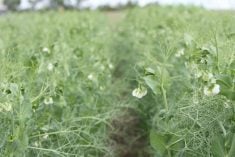Price direction in the flax market will depend on how many more acres farmers can combine this fall, says a market analyst.
Half of Saskatchewan’s flax crop was still standing in the field as of Oct. 10, according to Saskatchewan Agriculture.
The 10-year average is to have 73 percent of the crop in the bin by that time of the year.
“We’re well behind,” said Chuck Penner, analyst with LeftField Commodity Research.
He noticed flax bids edged up by nearly $1 per bushel at one of the line companies last week, indicating that exporters may be getting nervous about supplies.
Read Also

Prairies have variable soil moisture conditions
The dry weather in the west was welcome for preserving grain quality and advancing harvest, but it has resulted in very dry soil moisture conditions.
Statistics Canada estimates there were 274,000 tonnes of carryout from the 2015-16 crop, which is the largest since 2009-2010. But Penner said there is a lot of poor quality flax in that.
“It’s not all wonderful, exportable flax. Crushers would still be able to do something with it but at a discount.”
That is why there is mounting concern about how much Canadian flax will get harvested before winter sets in for good.
If harvest progress in Manitoba and Alberta is similar to Saskatchewan, that means only half of the anticipated 577,000 tonnes of production is in the bins.
However, Penner noted that the remaining crop can be harvested quickly if growers get good weather.
Flax prices have hovered in the $11.50 to $12 per bushel range for months. Where prices go from here will depend on what happens with the remaining half of the crop.
“If we do get the rest of that crop off, I could see us dipping maybe even below $11,” said Penner.
“If we don’t, we’ll probably see prices above $12.”
Growers shouldn’t expect prices to go on a bull run to $16 per bushel or anything like that because there was a big crop of 1.1 to 1.2 million tonnes harvested in the Black Sea region.
“If you compare it to Canada, it has become twice the size of the Canadian crop,” said Penner.
“The balance of power, if you want to call it that, in the flax market has shifted away from Canada.”
The Black Sea region will compete with Canadian flax in the European Union and China.
Canada’s other main flax market is the United States, where demand is expected to be sluggish, although better than last year. U.S. farmers harvested a big crop last year that is still weighing on export prospects.
Penner believes Canadian crop quality should be good because the crop had matured past the susceptible phase by the time the first frost hit.
But he said it could deteriorate over winter if farmers are unable to complete the fall harvest.
David Sefton, director of the Sask-atchewan Flax Development Commission, isn’t overly concerned about the yield or quality of whatever flax doesn’t get harvested this fall.
“It really doesn’t seem to affect the yield by doing it in the spring,” he said. “Two years in a row I’ve had standing flax over winter and I’ve got No. 1 for it when I’ve sold it in the spring.”
He believes supply and demand will be pretty evenly matched this year, so he does not expect to see price increases.
















